Editor's Note: The scientists pictured on these pages represent just a sampling of the hundreds of scientists who have advanced drug abuse research during NIDA's 25 years.
 Dr. Philip Portoghese at the University of Minnesota conducts research on analgesics.
Dr. Philip Portoghese at the University of Minnesota conducts research on analgesics.This year NIDA marks its 25th anniversary as a scientific institute. NIDA was established by Congress in 1974 to mount a scientific response to the increase in drug abuse that occurred in the U.S. during the late 1960s and early 1970s. Since its founding, NIDA has grown to become the world's preeminent generator and repository of scientific knowledge about drug abuse and addiction. Today the Institute has a budget of more than $603 million, which is more than a fourfold increase from just a dozen years ago and nine times what it was in 1974. NIDA supports more than 85 percent of all biomedical and behavioral drug abuse research conducted in the world.During the last 25 years, NIDA has responded to a series of drug-abuse related challenges to the Nation's public health. In the course of mounting a vigorous scientific response to these challenges, the Institute has constructed and carried out a long-range program of diversified research into the causes of drug abuse and addiction, the course of the disease, and how to prevent and treat it. NIDA currently supports a wide range of basic, clinical, and epidemiologic research into all aspects of drug abuse and addiction. Together with the Institute's science education, research training, and information dissemination activities, this research continues to replace old perceptions about drug abuse and addiction with new scientific knowledge that will enable the Nation to deal successfully with the medical, social, and public health problems associated with drug abuse and addiction in the 21st century.
NIDA's Roots
 Dr. Nancy Lee's work at the University of California at San Francisco shed light on the characteristics of natural opioids in the brain.
Dr. Nancy Lee's work at the University of California at San Francisco shed light on the characteristics of natural opioids in the brain.NIDA traces its beginnings to a small research unit at a U.S. Public Health Service hospital in Lexington, Kentucky. The unit was created in 1935 to study and treat heroin addiction among Federal prisoners and others who voluntarily admitted themselves to the facility. That research unit, which conducted pioneering studies into the nature of the addictive process, essentially spawned the science of drug abuse research. The unit eventually became known as the Addiction Research Center and became NIDA's Intramural Research Program (IRP) when the Institute was created in 1974. NIDA's IRP now conducts research at its facilities in Baltimore.
The 1970s
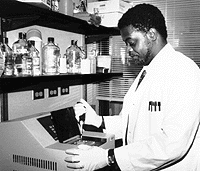 Dr. Jean Lud Cadet of NIDA's Intramural Research Program has studied the effects of drugs on human memory.
Dr. Jean Lud Cadet of NIDA's Intramural Research Program has studied the effects of drugs on human memory.In 1974, NIDA was officially established by Congress as the Federal focal point for research to increase knowledge about drug abuse, promote effective strategies to deal with the problem, and develop and manage a nationwide network of drug abuse prevention, treatment, and training programs. NIDA initially focused much of its research on heroin addiction and its link to crime. However, the Institute soon inaugurated research, prevention, and treatment efforts aimed at the entire range of drugs of abuse. Major events and accomplishments of the 1970s:
NIDA-supported scientists develop an animal model that shows that animals will self-administer most of the same drugs that people do. Researchers still use this model today to screen and characterize the abuse liability of new drugs and the treatment potential of new compounds being considered as drug abuse medications.
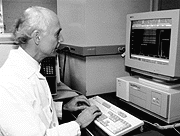 Dr. Edward Cone examines hair analyses for cocaine as part of his research in NIDA's Intramural Research Program to improve drug testing methods.
Dr. Edward Cone examines hair analyses for cocaine as part of his research in NIDA's Intramural Research Program to improve drug testing methods.NIDA scientists pioneer the development of state-of-the-art urine drug testing methods. This research has led to methodologies that are widely used today to detect illicit drug use. They have provided drug abuse treatment researchers, physicians, and other health care providers with valuable diagnostic instruments and prevention tools.
NIDA-supported researchers make a series of groundbreaking discoveries about the brain and its molecular and neurochemical methods of communication. The discovery of opioid receptors in the brain, identification of naturally occurring chemicals that act at these receptors to mediate mood and pain, and the finding that opiates such as heroin act at these same receptors revolutionized thinking about the addictive process and brain function in general. The concept of drug and receptor interactions provided the first clue about how drugs exert their effects in the brain and paved the way for development of new medications to treat drug abuse and other diseases.
 Dr. Vis Navaratnam of the University of Science of Malaysia, at an international meeting of epidemiologic researchers, stresses that policymakers need accurate, timely information from drug abuse monitoring systems.
Dr. Vis Navaratnam of the University of Science of Malaysia, at an international meeting of epidemiologic researchers, stresses that policymakers need accurate, timely information from drug abuse monitoring systems.The Institute initiates the Monitoring the Future Study. The annual study has been tracking long-term trends in drug use among the Nation's high school seniors for 24 years. In 1991, NIDA added 8th- and 10th-grade students to the study to identify possible developing trends in adolescent drug use.
NIDA establishes the first national-level surveillance network to assess current drug use patterns and identify emerging trends in major metropolitan areas around the country. This network, called the Community Epidemiology Work Group (CEWG), has been meeting semiannually for more than 21 years. Using the CEWG model, a number of State Epidemiology Work Groups in the United States and an International Epidemiology Work Group now monitor drug use patterns and trends around the world.
NIDA undertakes comprehensive research on nicotine addiction to study how the drug is absorbed and distributed by the . NIDA's nicotine research has defined the central role of nicotine in tobacco dependence and cigarette smoking, laid the groundwork for recent State and Federal actions to regulate the advertising and sale of tobacco products, and provided the scientific basis for the development of nicotine replacement therapies in the 1990s.
The Institute initiates research on the health and developmental consequences of prenatal drug exposure for infants and children. This research led to the development of a pharmacological treatment to ease newborn infants' withdrawal from prenatal exposure to narcotics. Today, NIDA supports more than 30 long-term studies of the effects of women's use of narcotics, cocaine, and other drugs on pregnancy, maternal health, and infant and child development.
The 1980s
 Dr. Linda Chang of Harbor-UCLA Medical Center operates a computer program that combines brain images to study the interaction of cocaine and an HIV-induced brain infection.
Dr. Linda Chang of Harbor-UCLA Medical Center operates a computer program that combines brain images to study the interaction of cocaine and an HIV-induced brain infection.NIDA's mission changed in 1981 when Congress legislated the Alcohol and Drug Abuse and Mental Health Services Block Grant Program, transferring to the States full responsibility for the delivery of drug abuse prevention and treatment services. NIDA maintained primary responsibility for supporting and conducting research on drugs of abuse. Additional legislation charged NIDA with expanding its dissemination of research findings to States, localities, and community organizations around the country. Major events and accomplishments of the 1980s:
AIDS becomes a major NIDA research priority because of the central role that injection drug use plays in the transmission of HIV. From 1986 to 1987, NIDA's budget increased dramatically to support new research on both AIDS and drug abuse with AIDS funding nearly tripling. Among the effective responses developed by NIDA were the National AIDS Outreach Demonstration Projects. These projects provided out-of-treatment drug injectors and their sexual partners with AIDS prevention and education messages, encouraged drug users to enter drug abuse treatment, and demonstrated that drug users can reduce AIDS risk behaviors.
An inexpensive, highly addictive, smokeable form of cocaine called "crack" makes its debut on the streets and spurs an epidemic of cocaine use. In response, NIDA expands basic and clinical research on cocaine and launches major cocaine prevention campaigns.
Expanded basic research on cocaine pays off when NIDA's intramural researchers identify a protein called the dopamine transporter as the primary site in the brain where cocaine acts to initiate the drug's euphoric and addictive effects. Today, NIDA-supported researchers are pursuing development of a number of promising cocaine treatment medications targeted at this brain molecule.
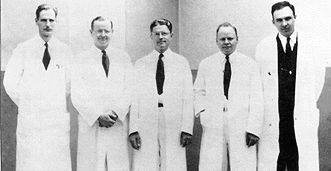 These pioneering drug abuse researchers worked at the Addiction Research Center (ARC), established in 1935 at a Public Health Service hospital in Lexington, Kentucky, and later to become NIDA's Intramural Research Program. From left, psychologist Ralph Brown, chemist Fred Oberst, psychologist and ARC's first director Clifton Himmelsbach, physiologist Edwin Williams, who would become ARC's second director, and biophysicist Howard Andrews.
These pioneering drug abuse researchers worked at the Addiction Research Center (ARC), established in 1935 at a Public Health Service hospital in Lexington, Kentucky, and later to become NIDA's Intramural Research Program. From left, psychologist Ralph Brown, chemist Fred Oberst, psychologist and ARC's first director Clifton Himmelsbach, physiologist Edwin Williams, who would become ARC's second director, and biophysicist Howard Andrews.After years of NIDA-supported research in collaboration with the private sector, naltrexone joins methadone as the only medications approved by the Food and Drug Administration (FDA) for treating heroin addiction. Naltrexone blocks heroin's effects and is used to prevent relapse to drug use among recovering addicts.
NIDA-supported researchers continue to build the scientific base for effective drug abuse prevention programs by identifying individual, family, school, and neighborhood factors that place children at risk for drug abuse and addiction. To date, researchers have identified a constellation of these risk factors and, equally important, a large number of protective factors that help to buffer the risk factors and reduce the likelihood that young people will abuse drugs. Drug abuse prevention researchers have since developed a broad array of effective family, school, and community programs that target these factors.
The 1990s
 Dr. Tony Strickland of Charles R. Drew University of Medicine and Science tests a volunteer for cocaine-related mental deficits.
Dr. Tony Strickland of Charles R. Drew University of Medicine and Science tests a volunteer for cocaine-related mental deficits.In 1992, NIDA became part of the National Institutes of Health (NIH). This landmark event affirmed both the quality of NIDA's research and its importance to the Nation's public health. As an NIH institute, NIDA has built on past research, engaged in collaborative research with other NIH institutes, and has seized the opportunities presented by new research technologies and methodologies in molecular biology, neuroscience, and brain imaging to accelerate the pace of scientific discoveries about drug abuse. Major events and accomplishments of the 1990s:
NIDA intramural and extramural researchers clone the dopamine transporter, cocaine's primary site of action in the brain. NIDA-supported researchers have since cloned the brain receptors at which every major drug of abuse acts to trigger the complex cascade of biochemical events that produces those drugs' psychoactive and behavioral effects. Researchers now use these cloned molecules to design and screen new compounds and medications approved for other conditions for possible efficacy as drug abuse treatments.
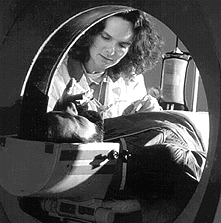 Dr. Nora Volkow of NIDA's Regional Neuroimaging Center at Brookhaven National Laboratory prepares for a brain imaging session using positron emission tomography to examine how and where cocaine acts in the brain.
Dr. Nora Volkow of NIDA's Regional Neuroimaging Center at Brookhaven National Laboratory prepares for a brain imaging session using positron emission tomography to examine how and where cocaine acts in the brain.NIDA establishes its Medications Development Division (MDD). The Division's mission is to focus and expand efforts to develop new medications that can be combined with behavioral therapies to improve treatment of drug abuse and its consequences. In its short lifespan, MDD has seen one opiate treatment medication through the FDA approval process (see LAAM, below) and filled NIDA's medications development pipeline with many other compounds that hold promise for treating cocaine, heroin, and methamphetamine abuse.
MDD successfully shepherds LAAM (levo-alpha-acetyl-methadol), a heroin treatment medication, through FDA's regulatory process. LAAM was the first new medication for the treatment of addiction to heroin and other opiates approved by FDA since the agency had approved naltrexone nearly a decade earlier. LAAM provides treatment practitioners with a long-acting alternative to methadone and is used to stabilize heroin addicts in long-term treatment. MDD currently has several next-generation heroin treatment medications, including buprenorphine and a longer acting form of naltrexone, in the latter stages of the FDA approval process.
The Institute establishes its Behavioral Therapies Development Program. The Program seeks to enhance existing behavioral treatments; develop, replicate, and standardize new behavioral therapies; and promote the use of those treatments that are effective in reducing drug abuse. The Program has produced a host of science-based cognitive-behavioral treatments for drug abuse and addiction, including new family therapies, relapse prevention approaches, brief motivational enhancement therapies, and improved counseling techniques.
 Dr. Christopher Evans, Duane Keith, and Dr. Robert H. Edwards, are members of the University of California at Los Angeles team that cloned the delta opioid receptor, one of the molecular sites in the brain where morphine binds.
Dr. Christopher Evans, Duane Keith, and Dr. Robert H. Edwards, are members of the University of California at Los Angeles team that cloned the delta opioid receptor, one of the molecular sites in the brain where morphine binds.NIDA inaugurates annual constituent conferences to obtain advice and recommendations on the Institute's activities from members of national organizations whose work is tied to drug abuse. Over the last 5 years, NIDA has implemented hundreds of activities, including major research initiatives, in direct response to constituents' concerns and recommendations about drug abuse issues.
NIDA expands research on women, gender, and drug abuse. Gender-based research now is integrated throughout NIDA's grant portfolio. The research seeks to identify the critical biological and behavioral factors that differentially affect the initiation, progression, and consequences of drug abuse and addiction in females and males of all ages and how these variables should be addressed in drug abuse prevention and treatment.
A new brain imaging center opens at NIDA's IRP in Baltimore. This center, and NIDA's new Regional Neuroimaging Center at Brookhaven National Laboratory in Upton, New York, affirm NIDA's commitment to brain imaging as a vital drug abuse research tool. Brain imaging studies conducted by intramural and extramural researchers have greatly increased understanding of the neurobiological basis of drug abuse and addiction.
 Dr. Eugene Oetting and his colleagues at Colorado State University examine the role of cultural factors in drug abuse.
Dr. Eugene Oetting and his colleagues at Colorado State University examine the role of cultural factors in drug abuse.NIDA launches major marijuana, heroin, and methamphetamine research and communications initiatives to counter increases in the abuse of these drugs by younger and more diverse populations. These initiatives have buttressed NIDA's research to develop new targeted approaches to reducing the use of these three drugs and associated health problems. These initiatives also have increased dissemination of the latest scientific findings about these drugs and approaches that can be used to stem their use.
The National Conference on Drug Abuse Prevention Research is convened to spread the word about effective, science-based school, family, and community drug abuse prevention programs developed by NIDA-supported researchers. To further aid communities in applying research findings to their local drug abuse prevention efforts, NIDA published and disseminated the first research-based guide to preventing drug abuse among children and adolescents.
 Dr. Shigeo Kitayama (left) and Dr. George Uhl are two of the researchers in NIDA's Intramural Research Program involved in cloning the gene for the dopamine transporter, a key protein in cocaine abuse.
Dr. Shigeo Kitayama (left) and Dr. George Uhl are two of the researchers in NIDA's Intramural Research Program involved in cloning the gene for the dopamine transporter, a key protein in cocaine abuse.NIDA inaugurates a series of Town Meetings to bring the latest scientific findings about drug abuse to communities across the Nation. These meetings have been helping to bridge the "great disconnect," the gap between scientific knowledge about the nature of drug addiction as a chronic, relapsing brain disease and public perceptions that it is solely a behavioral or social problem.
NIDA's Drug Abuse Treatment Outcome Study (DATOS), a major nationwide study of drug abuse treatment outcomes in the 1990s, finds that the most common forms of drug abuse treatment programs all are effective in reducing drug use. DATOS data also shows that treatment led to significant improvements in other aspects of patients' lives, such as increased full-time work and reduced involvement in illegal activities.
NIDA expands health services research to give drug abuse treatment and prevention service providers scientific data and research-based methodologies to gauge how well their programs work for patients in real-life settings. This research is giving service providers the tools to determine whether their programs provide cost-effective, accessible services that reduce drug abuse and addiction and related costs to society.
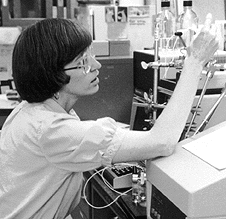 Dr. Elizabeth Eipper's studies at The Johns Hopkins University increased understanding of the processes that produce brain peptides.
Dr. Elizabeth Eipper's studies at The Johns Hopkins University increased understanding of the processes that produce brain peptides.To improve the quality of the Nation's drug abuse treatment, NIDA launches a Treatment Research Initiative. The Initiative is synthesizing research-based knowledge about the treatment of drug abuse and addiction, expanding research to fill gaps in knowledge, and increasing dissemination of the latest treatment research findings.
 Dr. Billy Martin of Virginia Commonwealth University has explored the dependence potential of marijuana.
Dr. Billy Martin of Virginia Commonwealth University has explored the dependence potential of marijuana.NIDA establishes its Center for AIDS and Other Medical Consequences of Drug Abuse to address the full spectrum of health issues associated with drug abuse. The Center develops and coordinates multidisciplinary national and international research programs on the link between drug abuse and HIV/AIDS, hepatitis, tuberculosis, sexually transmitted diseases, mental health conditions, and other health problems.
The Institute launches its Vulnerability to Addiction Initiative to increase knowledge of genetic and environmental factors and how they interact to increase or reduce vulnerability to drug abuse and addiction. Ultimately, the Initiative will increase understanding about the origins of drug abuse and addiction and provide knowledge that can be applied to the development of more effective drug abuse prevention and treatment strategies.
NIDA begins to develop an extensive clinical trials network throughout the Nation to launch the next generation of drug abuse research. This network will establish a partnership between drug abuse treatment researchers and practitioners to test, refine, and speed the adoption of effective drug abuse treatments to enhance existing community-based treatment programs around the country.
